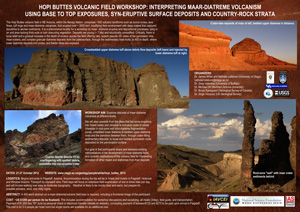This page was last updated by Nathalie while she conducted her PhD research at the Department of Geology, University of Otago. Find out what Nathalie is doing now on our Alumni page.
 PhD thesis: Volcanology of maar-diatreme volcanic vent complexes, Hopi Buttes Volcanic Field, Arizona, USA (PhD submitted April 2013)
PhD thesis: Volcanology of maar-diatreme volcanic vent complexes, Hopi Buttes Volcanic Field, Arizona, USA (PhD submitted April 2013)
Supervisor:James White, Alan Cooper
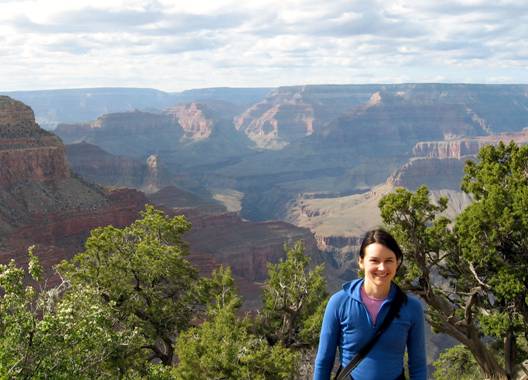
Hopi Buttes Volcanic Field Workshop
Hopi Buttes Volcanic Field Workshop: Interpreting Maar-Diatreme Volcanism using base to top exposures, syn-eruptive surface deposits and country-rock strata (October 2012)
Summary of Research Project
The main objective of my PhD research is to better understand the eruption behaviour of maar-diatreme volcanoes by investigating the lower volcano-structural levels of this volcano type. This is valuable because maar-diatreme volcanoes are the second most common volcanoes formed on land, the dominant volcano type mined for diamonds, as well as their eruptions are hazardous and difficult to predict.
Most parts of a maar-diatreme volcano develop below the land surface, and hence are completely encased by country rock and not accessible for study. Nevertheless, investigating the root zone and diatreme is critical to understanding the eruption behaviour of this type of volcano. Much of our current knowledge of how deposits form within the root zone, and the root zone's relationship to the diatreme, is from 1-D drill-core and 2-D open mine-pit faces mapping data obtained during diamond exploration and mining. The Hopi Buttes Volcanic Field located in northeastern Arizona (Fig.1) is one of the best known places in the world to study root zone and diatreme volcanological processes. This is because the Field has experienced varying degrees of erosion exposing the different volcano-structural levels of maar-diatreme volcanoes and revealing some of the finest 3-D exposures (Fig.2). The Hopi Buttes volcanoes are relatively young (approximately 7 Ma), and emplaced into well-studied, virtually flat-lying Tertiary mudstone and Mesozoic clastic and carbonate sediments that are part of the tectonically relatively stable Colorado Plateau (Fig.3).
The field-based study will encompass detailed volcanological mapping of four volcanoes that represent the different lower, vertical volcano-structural levels (i.e. the root zone, and lower to upper diatreme sections) of a maar-diatreme volcano (Fig.4). Mapping will provide information on the fragmentation style(s), relationship of the different volcano-structural levels, vent architecture and movement, near surface rheology of the magma, as well as insight into the hydrogeological conditions and mechanical properties of the local country rock at the time of volcanism.
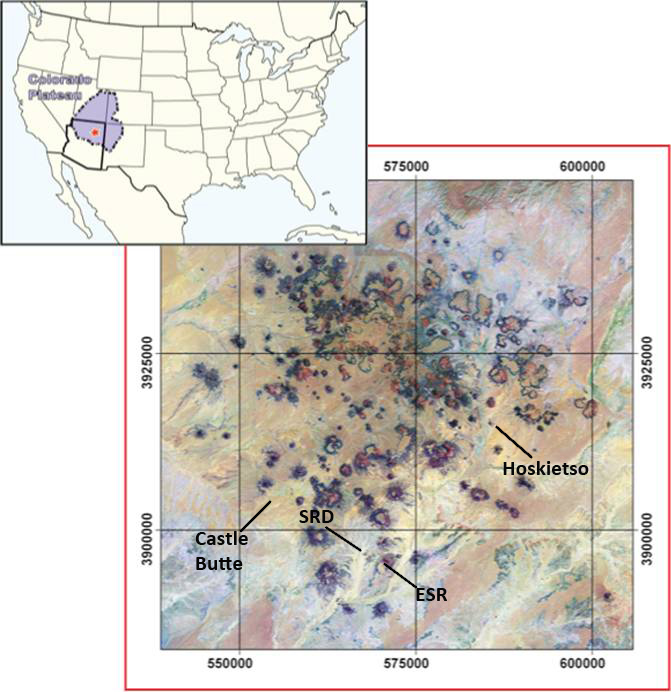
Fig.1: Location of the Hopi Buttes Volcanic Field in north-eastern Arizona and in the southern part of the Colorado Plateau (top left). Satellite image from Google Earth of the Hopi Buttes Volcanic Field and the location of the four maar-diatreme volcanoes that are part of the study: 1. Hoskietso diatreme, 2. Castle Butte, 3. Standing Rocks diatreme, and 4. East Standing Rock.
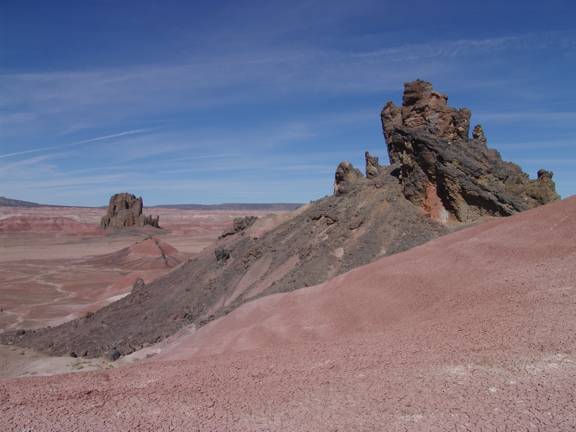
Fig.2: Photograph of the Standing Rocks maar-diatreme volcanoes showing the amazing exposure within the Hopi Buttes Volcanic Field.
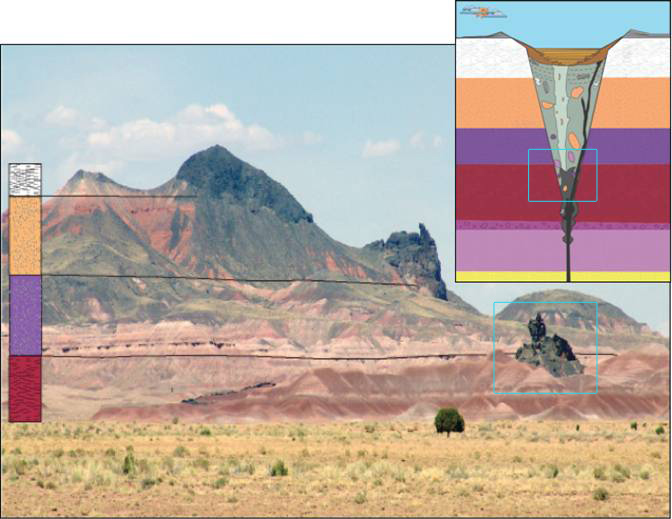
Fig.3: Photograph of the upper portion of East Standing Rocks vent (turquoise box) within the exposed country rock stratigraphy now 300 m below the original eruptive land surface. The main flat-lying sedimentary country rock packages are highlighted to the left of the photograph using different coloured boxes and contacts are marked by the black subhorizontal lines. Schematic diagram of a maar-diatreme volcano (top right; modified from White and McClintock, 2001) showing the volcano-structural level of East Standing Rocks classified by White (1991) marked by the turquoise box.
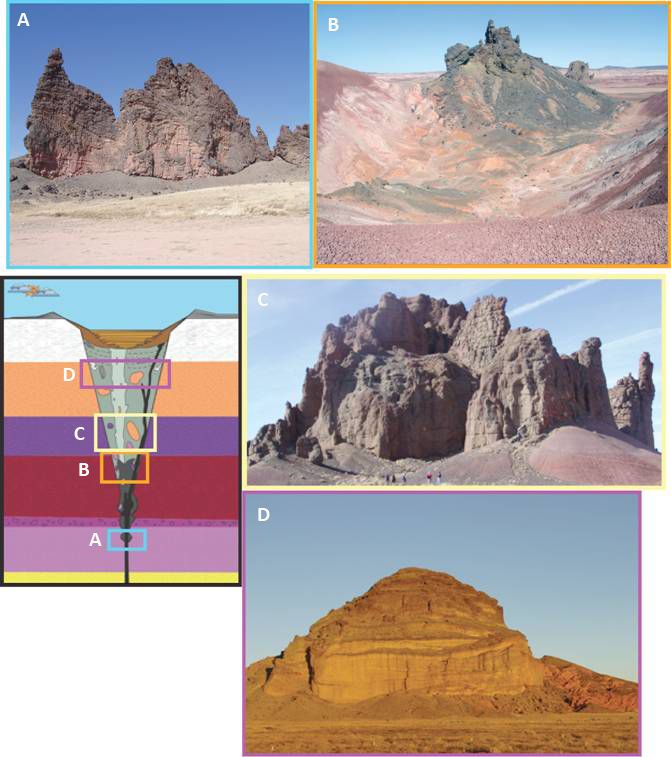
Fig.4: Photographs of the four maar-diatreme volcanoes that are part of the PhD study. Each volcano is exposed at a different volcano-structural level of the overall maar-diatreme volcano. A. Castle Butte exposed at the base of the root zone. B. East Standing Rocks exposed at the root zone / lower diatreme level. C. Standing Rocks lower diatreme. D. Hoskietso upper diatreme.
Publications
List of Published Papers
Lefebvre, N. and Kurszlaukis, S., 2008. Contrasting eruption styles of the 147 Kimberlite, Fort à Corne, Saskatchewan, Canada. Journal of Volcanology and Geothermal Research, 174, 171-185.
Lefebvre, N., Kopylova, M.G., Kivi, K., 2005. Archean calc-alkaline lamprophyres of Wawa (Ontario, Canada): Unconventional diamondiferous volcaniclastic rocks. Precambrian Research, 138, 57-87.
De Stefano, A., Lefebvre, N., Kopylova, M. G., 2006. Enigmatic diamonds in Archean calc-alkaline lamprophyres of Wawa, southern Ontario, Canada. Contributions to Mineralogy and Petrology, 151, 158-173.
List of Abstracts Presented at Conferences
Lefebvre, N. and White, JDL., 2009. Challenges in determining the volcano-structural level of a maar-diatreme remnant: East Standing Rocks, Hopi Buttes Volcanic Field, Arizona, USA. Joint New Zealand Geological and Geophysical Societies Conference, Omaru, New Zealand. (oral presentation)
Lefebvre, N. and Kurszlaukis, S., 2008. Variance in accretionary pyroclasts of the X-Ray Kimberlite, Ontario, Canada: Implications for interpretation of volcanic processes from drill core. 9th International Kimberlite Conference Extended Abstracts, Frankfurt, Germany. (poster presentation)
Lefebvre, N. and Kurszlaukis, S., 2006. Contrasting eruption styles of the 147 Kimberlite, Fort à Corne, Saskatchewan, Canada. Kimberlite Emplacement Workshop Extended Abstracts, Saskatoon, Canada. (oral presentation)
Lefebvre, N., Kopylova, M.G., and Kivi, K., 2003. Diamondiferous volcaniclastic debris flows of Wawa, Ontario, Canada. Geological Association of Canada and Mineralogical Association of Canada. (oral presentation)
Lefebvre, N., Kopylova, M.G., Kivi, K., and Barnett, W., 2003. Diamondiferous volcaniclastic debris flows of Wawa, Ontario, Canada. 8th International Kimberlite Conference Extended Abstracts, Victoria, Canada. (poster presentation)
Education
MSc. (Geology)
University of British Columbia, Vancouver, Canada
Supervisor: Dr. Maya Kopylova
Thesis: 'Petrology, volcanology, and diamonds of Archean calc-alkaline lamprophyres, Wawa, Ontario, Canada.'
BSc. (Honours Geology and combined Chemistry)
University of Western Ontario, London, Canada
Supervisors: Dr. Fred Longstaffe and Dr. Guy Plint
Thesis: 'The origin and significance of spherulitic siderite in the Dunvegan Formation, Alberta.'
Professional Experience
Earth Sciences Specialist: Kimberlite Petrology
Kimberlite Petrology Unit, De Beers Canada Inc., Toronto, Canada
Teaching Assistant
University of British Columbia, Vancouver, Canada
Field Geologist
De Beers Canada Exploration Division, Yellowknife, Canada
Junior and Senior Field Assistant
Monopros Limited, Yellowknife, Canada
Research Assistant
Stable Isotope Laboratory, UWO, London, Canada
Scholarships and Awards
- Commonwealth Scholarship
- Sigma Delta Epsilon-Graduate Women in Science, Eloise Gerry Fellowship
- Society of Economic Geologists, Hugh E. McKinstry Student Research Award
- University of Otago International Postgraduate Scholarship
- De Beers Canada Inc Outstanding Achievement Award
- Natural Science and Engineering Research Council of Canada Scholarship (Industrial Post-Graduate Scholarship)
- Egil H. Lorntzsen Scholarship Canadian Society of Petroleum Geologists Award Aleksis Dreimanis Prize
Professional Affiliations
- American Geophysical Union
- Association of Professional Geoscientists of Ontario
- International Association of Sedimentology
- International Association Volcanology and Chemistry of the Earth's Interior
- New Zealand Geophysical Society
- Society of Economic Geologists

